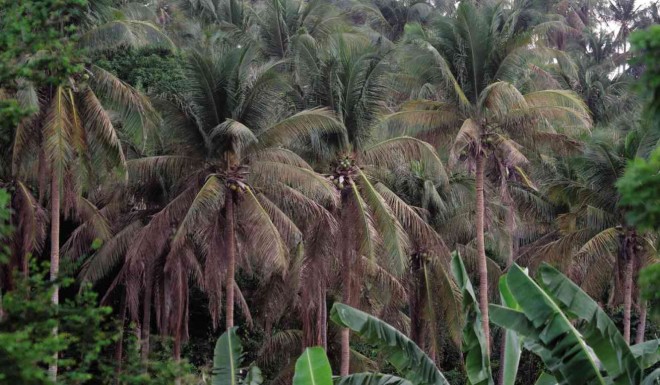Agency warns of return of ‘cocolisap’

COCONUT trees leaves gradually turn brown due to insect infestation in a farm in Batangas province. EDWIN BACASMAS / INQUIRER FILE PHOTO
SAN PEDRO CITY—The Philippine Coconut Authority (PCA) released thousands of natural predator insects to coconut farms in Laguna province as part of agency efforts to prevent a possible comeback of the coconut scale insects, locally referred to as “cocolisap.”
Although the pest population has dramatically decreased from what the government described as “of outbreak proportion,” authorities feared that the dry summer months would only upset an already improving situation.
“They (cocolisap) tend to be more active in reproduction during dry months. Although we saw a significant improvement, we could not be fully confident they are totally gone,” PCA Provincial Manager Jojo Alcantara said on Sunday.
The cocolisap (Aspidiotus rigidus) was first detected locally in 2009 in Batangas but scientists trace its origin to Sangi Island in Indonesia in the 1920s. It attacks coconut trees by feeding on the sap and causing the leaves to dry up and turn brown before withering away.
In 2014, the national government declared a cocolisap outbreak, affecting as many as 2.1 million coconut trees in the Calabarzon (Cavite, Laguna, Batangas, Rizal, Quezon provinces) and in parts of Mindanao.
Article continues after this advertisementArticle continues after this advertisement
Massive control protocols
The PCA, with a P400-million budget, launched massive “control protocols” that included leaf pruning, Neonicotinoid trunk injection, and the release of biocontrol agents or insects that feed on the cocolisap.
Some scientists and environmental groups, however, criticized the use of Neonicotinoid, a type of pesticide, saying it might cause harmful effects on the tree and the harvest.
“(Trunk injection) was done during an outbreak. If we had not done that, (the cocolisap) might have spread to other regions,” Alcantara said in a phone interview.
The PCA also attributed the decline in the pest population to Typhoon “Glenda” in July last year, which could have wiped out a significant number of cocolisap.
In Laguna, with about 8 million coconut trees, the PCA recorded about 500,000 initially infested, but the number was reduced to 146,000 as of March, Alcantara said.
Risks of outbreak
Of the remaining infested trees, about 52,000 trees have been pruned since March, with only two remaining areas—Bay and San Pablo City—considered “hot spots” or areas with risks of an outbreak.
“The (coconut) production really went down. Just imagine one tree produces an average of 45 nuts,” he said.
On Saturday, Francis Pangilinan, presidential assistant for food security and agricultural modernization, led an information caravan in Majayjay, one of the affected towns in Laguna. A similar caravan was held in Batangas last month and another will be held in Quezon.
About 1,000 biocontrol agents (consisting of five insect species —Chilocorus nigritus, Telsimia nitida, Telsimia sp., Pseudoscymnus anomalus and Cybocephalus sp.) cultured by the PCA were released in a 1-hectare farm in Barangay (village) Suba.
Laguna also plans to culture these biocontrol agents, according to provincial agriculturist Marlon Tobias.
Alcantara said the government had allotted 250,000 coconut tree seedlings for distribution to Laguna in the next six months.